#Also historical figures
Explore tagged Tumblr posts
Text
I should stop using flower language and plant related myths to hide messages through my writing.
You wish, of course I won't.
#Also historical figures#Important dates#word games#Mythology. Angeology and demonology#Damn I love twisting texts so there's plenty of meaning and no correct answer
1 note
·
View note
Text


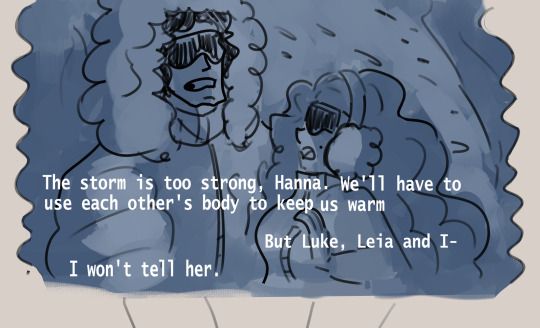

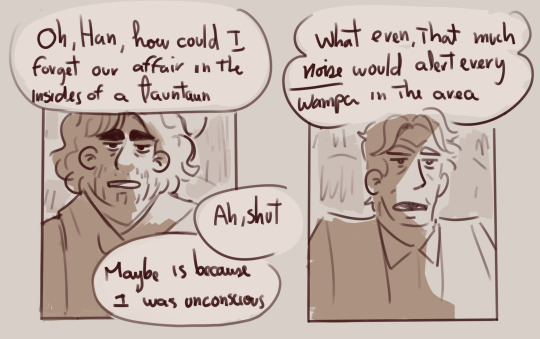
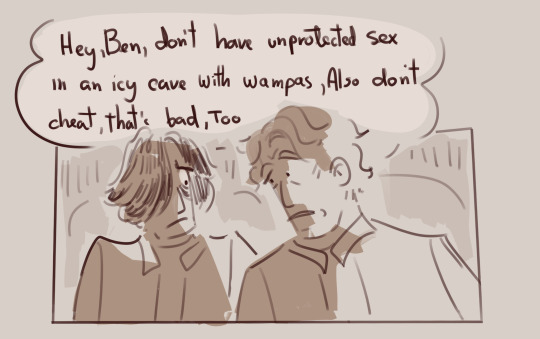
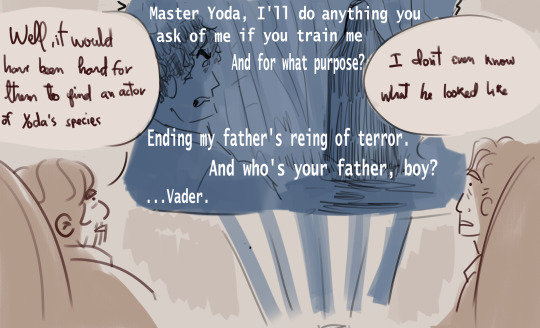

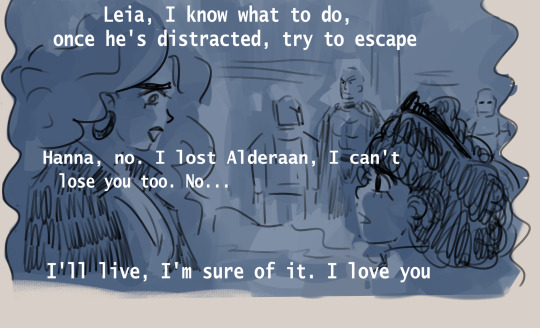
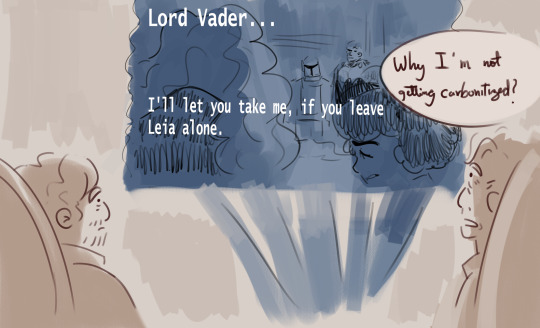
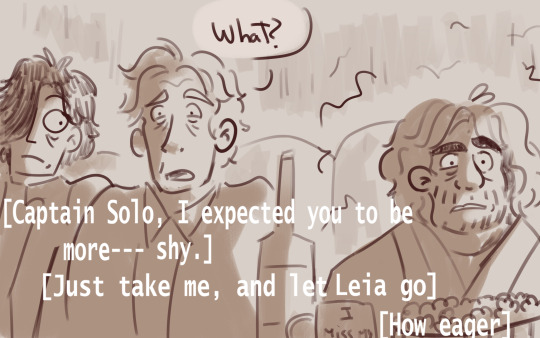
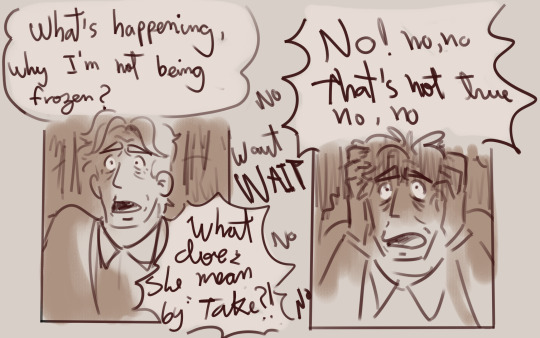
First. || Second
Empire strikes back
Ah yes, finally I made the next part of this awful thing. I lost a lot of energy for it after i lost the work of several pannels and had to start from zero, but hey, here it is.... :]
#star wars#luke skywalker#han solo#ben solo#darth vader#my art#silly posting#sequels era#i have a very specific director and his movies on mind for this parody but honestly this kind of thing happens a lot like even in Aladdin#but also besides that director inspiration i remember when in school the homework was watching a biopic of a historical figure and i swear#it was mostly sex and i'm not only very aroace but i also was like 14 so i was extremelly grossed out#long post
424 notes
·
View notes
Text

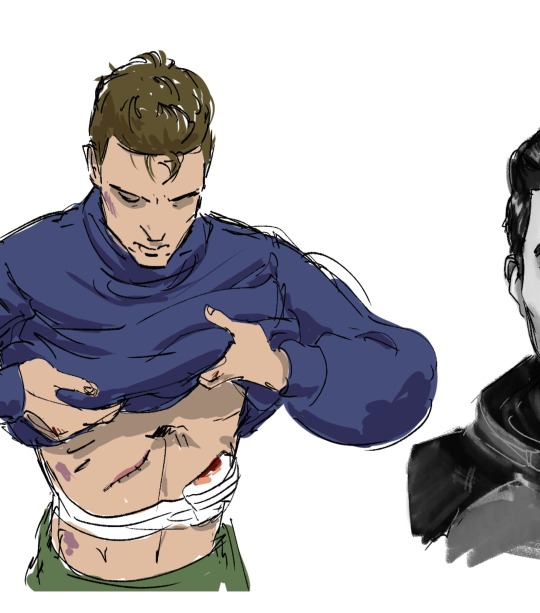



Patho fanart of varying quality
#*combines my interests like ingredients in a soup* you WILL look at my historic clothing doodles I COMMAND you to#pathologic#мор утопия#daniil dankovsky#artemy burakh#burakhovsky#<- as a treat#trying to figure out how to draw artemy is giving me a migraine#he was designed in a lab to be as difficult to draw as possible#also#Daniil is ukrainian. to me#shamelessly projecting my ethnicity onto fictional characters once again#don’t think too hard about the social/economic implications of artemys clothing#I just like the trim look that kaftans have….#my art
396 notes
·
View notes
Text
So, Apollo and jewellery!!
I want to start off by saying that Apollo (or any male god, really) wearing jewellery is not a common occurrence in the ancient greco-roman art forms. So there's not a lot you can get, but I've put together whatever I've found so far.
On the vase paintings, you'll find body chains across his chest and there's bracelets too:

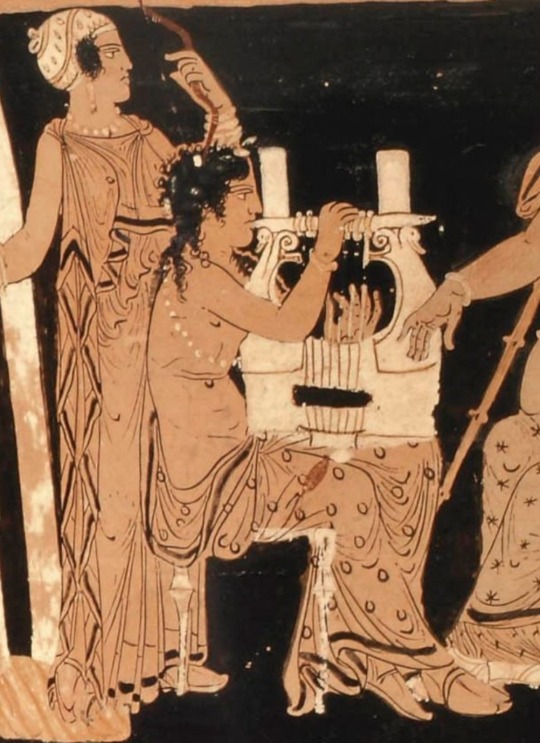

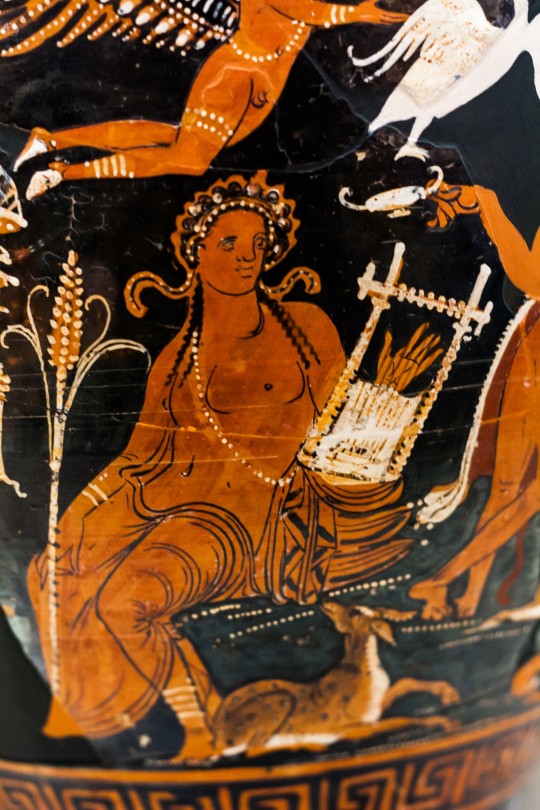
^ He also has a leg bracelet in this one
In this painting, along with a body chain and a bracelet, there's a thigh band and a finger ring as well.

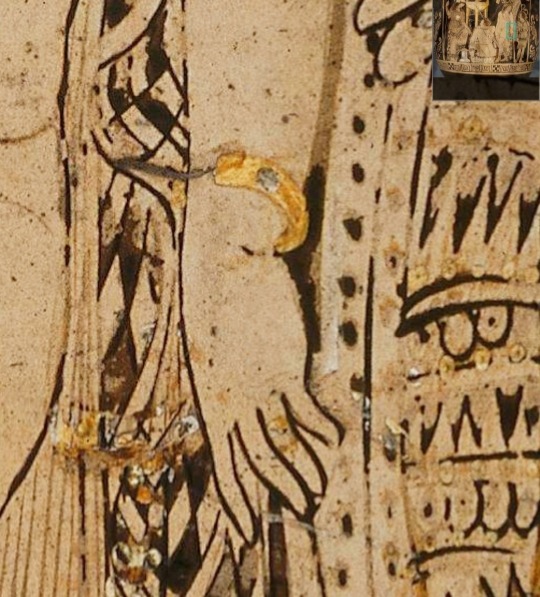
Then we have waist belts. I did entertain the possibility of this being an embroidered belt. However in the first image, the belt is gilded with gold, so imo it's meant to be a belt with gilded gold, if not made entirely of gold.
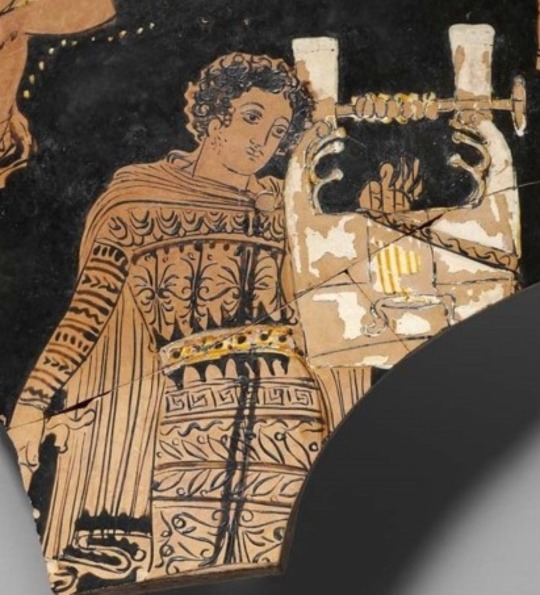

In this Etruscan painting representing Apollo going to/coming back from Hyperborea on a swan, he's wearing necklaces.

Apollo wearing a necklace and an arm band seems to be a fairly common sight in the Etruscan art (so Aplu, technically ig), as seen in these two statuettes:
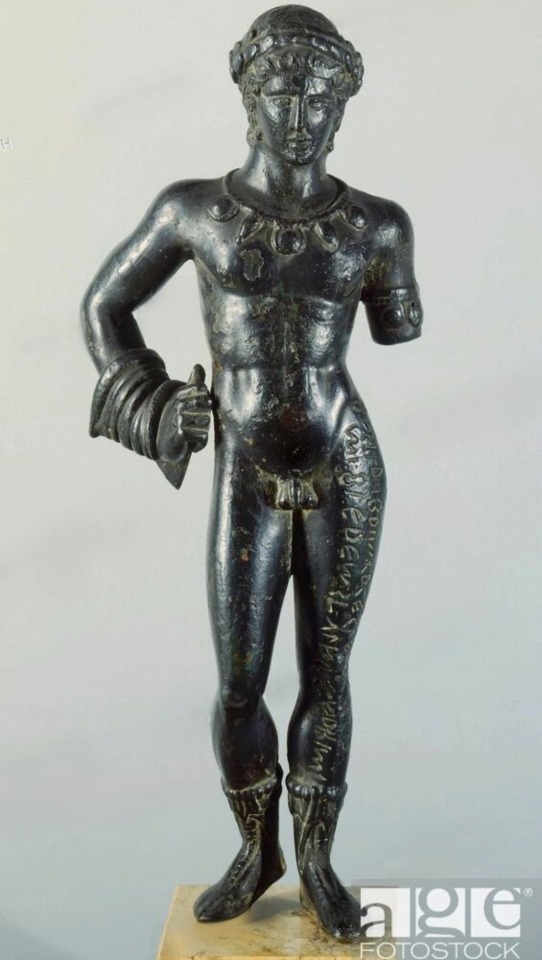
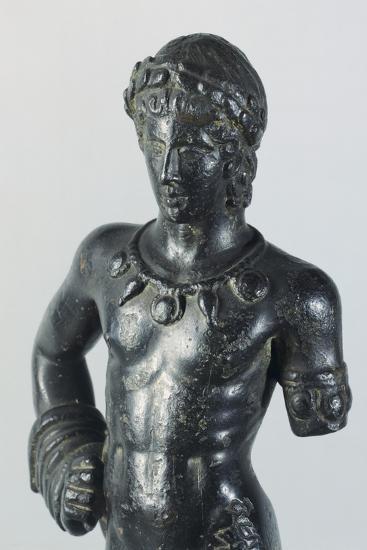

and some Etruscan mirror arts:
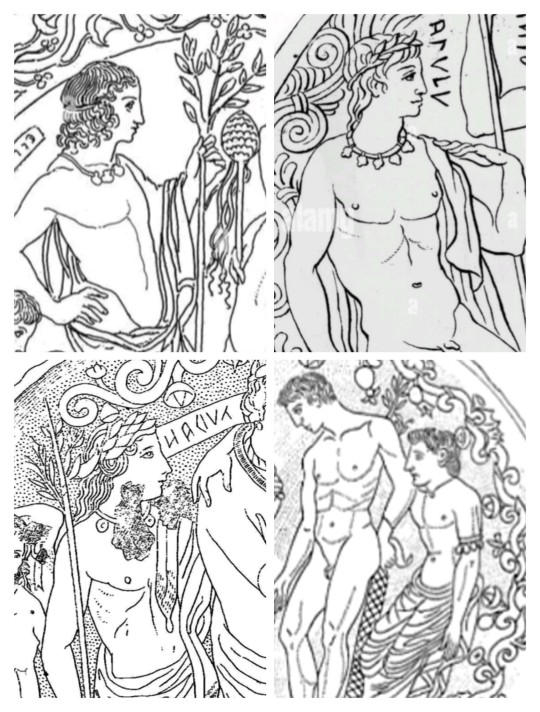
Now moving onto the diadems! A diadem referred to something you could tie your hair with - it could be a ribbon, a wreath of fresh leaves, or a jewelled wreath/head piece - it's the last one that I'm counting as jewellery. Diadems like the one Apollo is wearing below were usually worn by noblewomen.

You can also find depictions of Apollo with a jewelled wreath on his head. They resemble a laurel wreath, but they're made of gold, and have gems embedded. Here's a statue for example:

There are also Roman frescos and mosaics that show you what it actually looks like in color.

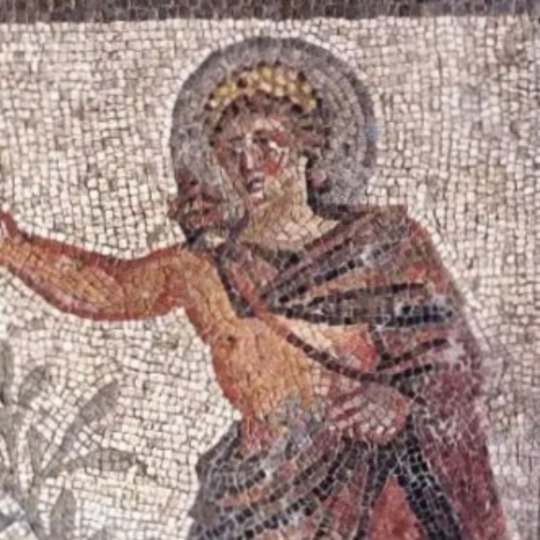
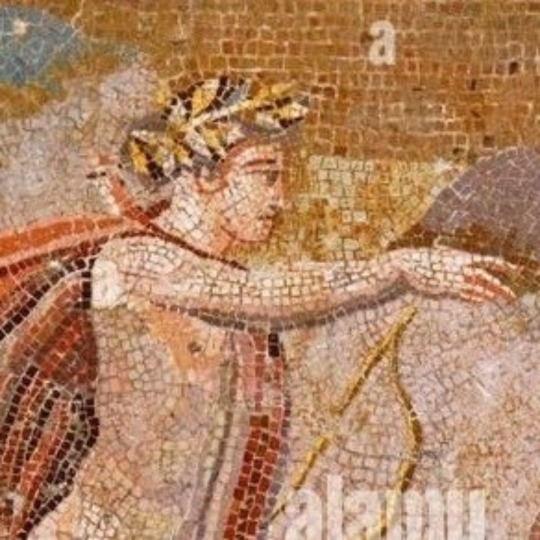

And here, you can see not just a gold diadem, but also bracelets on both his hands as well as anklets on his legs:

And there's what seems to be earrings as well? But honestly I'm not that sure, it could just be a damage on the fresco (even if that's the case, we can still appreciate the winged eyeliner amirite)

There's also this fresco of Apollo judging a beauty contest between Venus and Hesperus. Here he is not wearing a gold wreath, but there is a gold band upon his head:
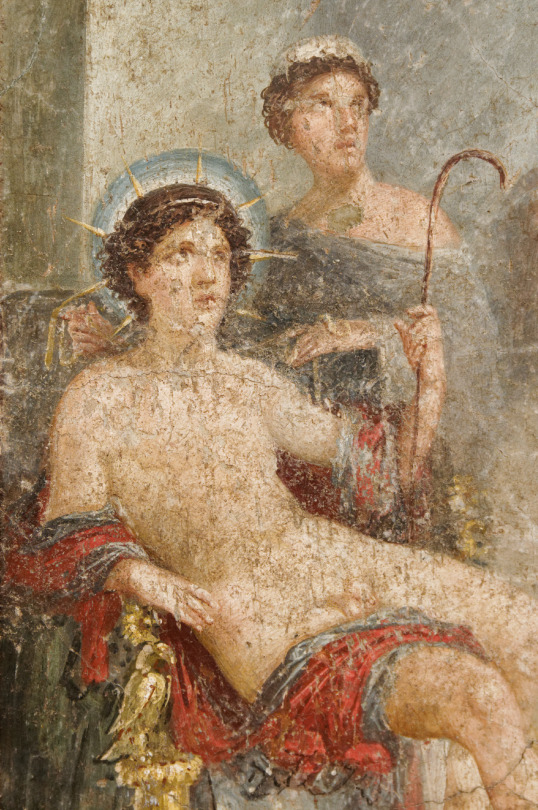
And unlike other pieces of jewellery, you'll find literary references as well for Apollo's diadem:
"When Apollo was born, Zeus equipped him with golden headband and lyre and gave him also a chariot of swans to drive" – Alcaeus, Hymn to Apollo (trans. David A. Campbell)
"Apollo puts his hair in order by shaping his flowing locks with soft foliage and braiding it with a golden diadem." – Virgil, Aeneid 4 (trans. Ingo Gildenhard)
"...he fastens bay about his lyre and the woven brilliance of his coronet, and ungirds his breast of the pictured girdle..." – Statius, Thebaid 6 (trans. J. H. Mozley)
"But you will say, Phoibos has a goldgleaming diadem." – Nonnus, Dionysiaca 4 (trans. William Henry Denham Rouse)
[Inscription]: "Apollo the mighty, Lord incomparable of the Diadem, who hath set up statues of the Gods in this kingdom" – Ammianus Marcellinus, History 17 (trans. John Carew Rolfe)
[Inscription]: "Mighty Apollo, seated upon truth, Lord of the Diadem, who hath gloriously honoured Egypt as his peculiar possession" – Ammianus Marcellinus, History 17 (trans. John Carew Rolfe)
And that's pretty much everything I've come across so far. I was a bit surprised at the lack of literary references for the effeminate gods. Not just Apollo, even Dionysus' effeminacy is described by his fair face and long hair and perfumed garments, and there are no mentions of jewellery afaik. But of course, just like with Apollo, you can find jewellery on Dionysus in the visual arts.
#Apollo#“is that an earring or just a very strangely drawn earlobe?” <- me looking at some of the vase paintings#and it was indeed a weirdly drawn earlobe everytime#lol#also I was internally giggling when I was zooming in on Apollo's finger ring in that one painting#i know rings as symbols of betrothal wasn't a concept in that time period but-!!#i couldn't help but think “ooooh who gave him the ring? 👀”#also anyone who knows more about ancient greek jewellery please tell me if men wore body chains at all??#because I couldn't find anything to support that historically#but in the paintings several male figures wear it so it couldn't be coming out of nowhere right??#mine#apollo info#jewellery
223 notes
·
View notes
Text

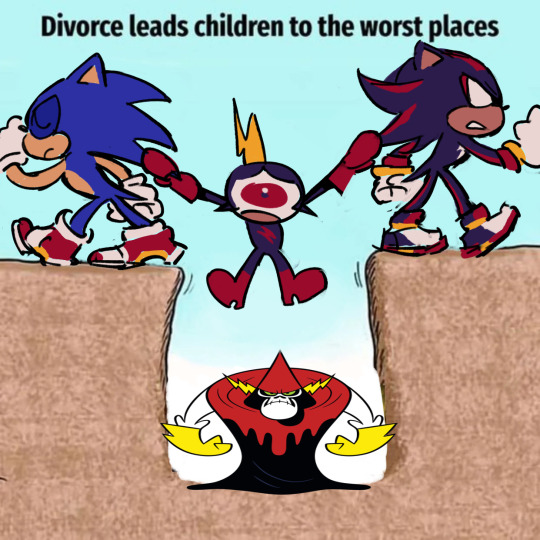

no context for. any of these
#ok some context for thomas jefferson peepers#i think watchdogs back on their home planet draw fanart of him like that cuz hes basically like a historical figure to them#n also cuz its funny asf#woy#wander over yonder#save woy#art tag#meme tag
266 notes
·
View notes
Text
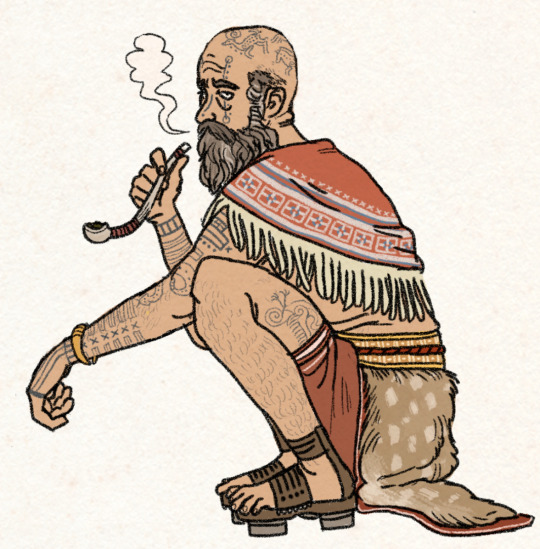
A witch of the Naig-Troibadnnas (Yellowtail river valley) people, resting and enjoying a smoke of the mild stimulant brolge leaf on a hot summer day.
Witches are a small part of the everyday cultural framework among the Hill Tribes. They are individuals considered born possessed by a virgranul, a type of disembodied wild spirit that seeks to inhabit human flesh, either entering the body at the moment of conception, or entering the body at the moment of death. The latter is a dire circumstance that requires significant intercession to fix (the dead body may wander off without rites, leaving the person's soul trapped and liable to warp into the dangerous fuldaigh spirit), while the former circumstance is what causes a person to be born a witch.
In the case of those afflicted in the womb, possession by virgranul is lifelong, and is both a curse and blessing- it divides and isolates them from the human world and causes other wild spirits (both benevolent and malicious) to be perpetually drawn to them, but also allows for them to be attuned to the subtleties of spirits, and able to work magic and divination that the everyday person is incapable of.
Witches are usually recognized from a young age due to marked behavioral differences or atypical development, though are sometimes simply identified as such without obvious behavioral indications, by other witches having read signs of their coming. Their occurrence is not frequent, usually once in a generation for any given tribe. An identified witch child will be taken from their family (the timing varies by tradition, though is usually upon puberty) and into mentorship by an established witch, who will impart their accumulated knowledge and skill and teach the child how to best harness their condition.
One can be a witch regardless of their gender, with the only commonality being that they must remain unmarried, and are expected to never have children (deemed too dangerous, unavoidably placing a child in the path of potentially harmful wild spirits). With no spouses or children to support them in holding a household and herds, witches are instead supported by their communities as means of payment for their services. They typically live in semi-isolation in the boundaries between the village and wilderness (a reflection of their own division between the world of people and of wild spirits, and a protective measure for their communities), and will periodically be brought needed supplies. They do not commonly enter villages unless summoned, or for the sake of certain holidays and festivals, and live most of their lives in seclusion aside from any given mentee (who will in turn care for their mentor in old age).
The societal function of witches is as intermediaries between people and their ancestors, people and wild spirits, and as especially skilled performers of practical magic (most commonly weaving protective spells into worn items, such as clothing or the nose rings of cattle). Forms of practical magic and intercession with ancestors and spirits are performed by all members of society, but a witch has intimate, detailed knowledge of such things and tremendous natural skill that makes them an invaluable asset.
Witches personally discern the identities of the spirits living in any given area and will attempt to familiarize themselves with them, learning in depth about their ways, giving warnings of where the particularly dangerous (or mischievous) ones are, and giving recommendations on which will be receptive to offerings in return for boons. When a village needs to commune with a particularly powerful or dangerous spirit (such as a wildfolk witch), they will commonly send their own witch as an intermediary.
They are ascribed have the ability to directly summon ancestors (who otherwise come and go of their own volition, and rarely ever deign to come at the call of one who is not their descendant). This is of great use when a person finds themselves punished by their ancestors with no certainty as to why, or cases where an orphaned child's ancestry must be identified to gain them proper spiritual support.
They are also regarded as having innate qualities of divination, particularly in reading birdsign (itself generally acknowledged as communication from ancestors, and occasionally gods). The average person has basic knowledge in reading omens of birds and a learned repertoire of key signs, but a witch can divine the messages of birdsign in immense and specific detail, through a vast knowledge system of the meanings of the species, sex, flight direction, gaze, prey, number, and songs of birds. It is common for people to approach a witch for a reading of the skies before undertaking a significant venture or life change, in order to receive detailed and specific advice.
Witches are always literate (and will be taught to read and write by their mentor if they cannot already) and will record their repositories of knowledge in tomes. These are items of absolute secrecy and taboo for a non-witch to touch (the consequences can be severe, you really don't want a witch ancestor-spirit upset with you). Witches can often become competitive about the knowledge stored in these tomes and are known to organize heists amongst themselves in order to gain access to each other's secrets. Most people avoid getting themselves entangled into the complicated rivalries of witches, as these competitions can get ugly and result in many a petty curse if one gains a witch's ire.
---
The only visual cue distinguishing this man as a witch is the tattoos on his forearms, otherwise usually regarded as inappropriate to mark in the contemporary Hill Tribes cultural sphere (the face, upper arms, and sternum is reserved for important clan/tribe/ancestry identification, hands and forearms are reserved for witches, and the rest of the body is appropriate for decoration). These unique forearm tattoos indicate his ancestral connection with a lineage of witches, not blood ancestry but rather the generations of mentors that have produced him. The lines extending down to his fingers are the newest, indicating that he has fully mentored another witch and gained a place in this ancestral line.
The rest of the tattoos here are tribe and blood ancestry identifiers (on the face and upper arms respectively, worn by all members of society), and purely decorative imagery (visible here is a deer, horse, eagle, and a dragon). He also has a snake on his forearm, applied decades ago in an act of youthful rebellion, which has since gotten in the way of critical open skin space.
His clothing is otherwise typical wear for warm seasonal conditions- a man's wool shawl and woven belt, short trousers, decorative deer hide (distinct to the Naig-Troibadnnas), and sandals (these are imported Wardi style sandals, which have been modified with preferred elevated heels). The horn shaped torc on his forearm identifies him as an esteemed elder.
#I think I mentioned the witch tradition by implication in a couple posts but it hasn't come up directly#Witches here are very frequently going to be autistic or having other developmental disorders- with non neurotypical development#and behavior (though without marked intellectual disability) being seen as the impact of possession by virganul.#There's a parallel tradition of witches among the contemporary Finns (distant sibling cultural group to the Hill Tribes) but of MUCH#more core societal significance in which witch-kings are the central figures of power.#Both developed out of common ancestral traditions which diminished in centrality in the Highlands (witches going from clan#leaders to 'guy living on the outskirts of your village who you go to for magical assistance') and increased in centrality in Finns#(witches going from clan leaders to kings with magical powers granted by the gods)#You see a version of the historical predecessor for witches in the drawing of Kulyos and Bernike wrt his forearm tattoos#The proto-Hill Tribes would have regarded their chieftains as a type of witch and the tradition of marking the forearms would#have originally been exclusive to said chieftains. The societal centrality of witches has been lost but they retain traditions of#markings that would have originally identified them as leaders.#(That drawing is also a imaginative though and not just for the bird woman. He's wearing contemporary dress.)#hill tribes#\
231 notes
·
View notes
Text
Bridgerton time travel to just before season one.
Anthony immediately breaks up with Sienna and starts arraigning things for Kate's family arrival. Before being reminded by his mother and Benedict that he is Viscount Bridgerton first and others can help the Sharma's get settled in England.
Kate tells Mary that they are going to England now and tells Edwina to forget all that she told her about marriage, and she'll help her find a love match. Once she gets married to Anthony, after a decent engagement period, she starts helping Daphne, Lady Danbury and Violet with items that require a lighter touch then her husband's.
Benedict finds Sophie and gets her out of Araminta's clutches. Then he helps Anthony with various legal/financial matters to support all of their family and friends in the future. He also continues his art because he loves it.
Daphne helps Sophie find employment in the meantime and works with her mother to set up other social matters that will help them in the future.
Sophie is using this opportunity to help Posy get away from her mother as well. Lady Danbury eventually offers her room and board as a Governess for her grandson Gareth.
Colin starts to publicly court Penelope. She insists that he still travel and start his journals, and they can have a long engagemnet. He of course brings back gifts for everyone, even people who aren't legally in his family yet. He also takes Albion and Harry under his wing and has them hang out with the rest of the Bridgerton men.
Penelope takes this chance to improve her spy network Whistledown sources. She also makes sure to set up her sister's with their future husbands and warns her mother that her father is in worse trouble then she suspects. She and Eloise bring Madame Delacroix into their spy network inner circle. She uses her new excess funds to help various friends that are or will be in need.
Simon immediately courts Daphne and secretly finances the Sharma's ship passage. Then he gets roped into helping Lady Danbury and her various "charity cases" (she swats him for that).
Lady Danbury does her best for her various family members. Improving her relationship with her brother, arraigning outings with Gareth and the younger Bridgerton siblings. While keeping an eye on her nephews James and Marcus. She also takes every chance to invite Posy but not Araminta or Rosamund over to her house. As do the Bridgertons and eventually the Featheringtons. She also takes an interest in a young Lucy Abernathy.
Eloise does her best to support all of her siblings and their soon to be spouses. Meanwhile she's helping Penelope with her spy network Whistledown. She's also subtly trying to get Cressida to be nicer and convince her to set her hat on Lord Debling when he returns. She also talks about her new penpal Mr. Crane and his love of plants.
Philip Crane makes it look like George and Marina got secretly married before he left for war. That way her children are legitimate, and they don't have to marry. He and Eloise start up a correspondence again.
Francesca Bridgerton worries about choosing between John and Michaela but they both reassure her that they love her and are fine with whatever she chooses. They all spend as much time together as they can knowing John's time is short.
Gregory and Hyacinth are frustrated by being children again but decide to use it to their advantage and get even more info for Whistledown. After, of course, making sure that they have regular outings with Gareth and Lucy. They might have to wait to be married but they are going to be around their loves as much is proper until they are all of age.
Lady Bridgerton is delighted all of her children are in love and working to better the lives of their friends. She works with Daphne on subtly bettering things in the Ton. And is open to meeting with Lord Anderson when he is in town. But she makes sure all of her children are being "proper" before marriage to avoid any scandals. She decides to make Portia an actual friend and help her with her husband wrangling. (she often assigns her sons or her sons in laws to keep an eye on him at various locations). Mary joins them when she comes to town. They all get tipsy at Agatha's on occasion to let off steam.
I'm sure they're all getting up too much more mischief, but I can't think of anything else to add. Or who else they are forcefully adopting helping.
If somehow Queen Charlotte traveled as well, she's getting her sons to marry their wives sooner and letting her children know she loves them. She is spending more time with her granddaughter. She hopes that things will be different but knows her death cannot be changed. She also engages Penelope in a long-distance chess match, with Agatha having go between to inform the other of their next moves. When he's having a good day she's having family meals with George and their family. She still picks her Diamonds but its not as fun when she knows the Bridgertons have the whole Ton rigged now. However, they do know how to get things done and she can appreciate that.
#bridgerton#time travel#all the family#that includes the spouses and their forcifully adopted friends#Bridgerton Oprah style#you get to be a Bridgerton#what are the Mondrichs or Lord Anderson up to you ask#no idea i say#as neither are book characters or historic figures#Genevieve Delacroix is just running her business and making friends#Marina is just relaxing now that she can be pregnant and not worry about her kids being illegitimate#Portia is confused about Penelope's change at home#but she's getting things done and her girls married#so all she has to worry about is Archie#and Violet is helping with that#Prudence and Philipa are happy to have loving suitors and new dresses#Posy doesnt know what to do with all the positive attention she is getting#dont know Lucy and Gareth's stories as well#so cant say who or what besides the Bridgertons they're focused on helping#jeez i used “also” alot in this
161 notes
·
View notes
Text


Worm!!
#sewing#handmade#worm off the string#giant worm on a string#idk what it is with me and giant worms lately#I also don’t know what I’m going to do with this work#*worm#this worm is about three feet long#for some reason I’m thinking maybe its name should be Garibaldi?#but upon looking up the name (because it rang a bell)#perhaps I should research the historical figure more before deciding. I only knew about the fish#it’s just a fun name to say. maybe I’ll name it Archibald
107 notes
·
View notes
Text


“I will write love letters to you that will still be read a century after we are gone.” — Pietro Bembo to Lucrezia Borgia, July 1504
A lock of Lucrezia Borgia's hair displayed in a glass case at the Pinacoteca Ambrosiana in Milan. It was discovered around 1680, was preserved along with love letters between Lucrezia and Pietro Bembo.
#there's also a book (which i'm about to read very soon) that transcribes their love letters !!#it was said their love letters to each other were considered the most beautiful love letters of all time#and when i do some historical revisionism and make them about lucrezia and cesare instead then what...#jokes on bembo though !! even juan's letter to lucrezia about loving her and missing her were more romantic aww don't make that face#hopefully bitter history nerds won't be taking what i say in the tags very seriously#lucrezia borgia#the borgias#history#italian renaissance#borgia#pinacoteca ambrosiana#renaissance#borgias#historical#historical figures#milan#italy#tb text post
55 notes
·
View notes
Text
They keep giving Burn Gorman small roles with fuckass haircuts and atrocious outfits in movies because they know people wouldn't know how to control themselves if they didn't, they don't want the masses to see how beautiful and powerful he really is because then the public will wake up to the realization these conventional Hollywood appearance standards are all bland and empty and they'll have to admit continuously hiring a stream of generic featureless pretty boys was a mistake and concede to the fact that the people yearn for Burn, which the world is just not ready for, BUT I AM; please please please give that man an actual major lead role in something good where he's not evil and doesn't die and isn't just a subplot there for a short amount of time, and leave his hair alone, I'm begging you, he may look scary to YOU, but his attractiveness just slapped me in the face like the hand of God, and his acting has taken hold of me, leave me alone
#burn gorman#ignore me#sorry for unhinged posting on here i like to yap one day i will use this blog for its intended purpose again one day#i'd watch turn but the historical figure character assassination as explained to me by my history (and Burn) lover friend sounds atrocious#also upset with the oxford murders why did his weird russian accent lines seem dubbed??? why did they do that to him?? (along w/ costuming)#i found one movie where it sounded like he has a lead role and it literally doesn't exist anywhere online#or physically#i want him in a romcom give him to me
81 notes
·
View notes
Text
The only thing I disagree with is the implication that Bechdels transphobia to trans men is not as serious, because it is. But in this case she has also done a lot of important activism in other areas which is why she's a legend in the lgbt community, and the flaws in her work and her personal politics cannot be overlooked. And in comparison to Andrew Hussie, her work is obviously more significant. Obviously. Andrew Hussie has always been an OPEN racist bigot who wrote the n word into their comics and just cause a bunch of white lgbt ppl found solace in a comic made by a blatant bigot who encouraged children to say racist, ableist, transphobic, misogynistic slurs doesn't make homestuck in any way comparable to Bechdel's comic.
You don't get to point the flaws out in the work of a lesbian historical figure just so you can get people to ignore the work of done edgy cunt who hasn't done a minute of actual lgbt activism in their life. If we're holding everyone accountable we will hold anyone accountable, get a grip.
#and i encourage not idolising historical figures but i am also not going to tolerate anti intellectualism in favour of some stupid racist#comic written by a white person who loves being racist
168 notes
·
View notes
Text
again so sorry im still on gladiator 2 but i cant stop thinking abt it (derogatory). it shows exactly the type of surface level "progress" we made in the last 2 decades. literally gladiator but "woke" as conservatives think of it bc that racial diversity n inclusion of lgbt characters is entirely surface level n covers up existing racism, eurocebtrism n homophobia.
they try to show rome as a brutal imperialist force spanning 3 continents for exactly 10 minutes, and then forget about it. no more discussion of imperialism and its consequences on both colonized ppl n colonizers. the message is 'rome is an empire built upon the blood of enslaved n colonized ppl. it could b good tho. it could b a REPUBLIC built upon the blood of enslaved n colonized ppl #progress'.
they were characters who were explicitly mentioned to enjoy n seek out gay sex, but these characters were either not shown or the villains. the brothers were rly effeminate as well to show how theyre morally corrupt, as one does when they try to present men as decadent, corrupt and morally reprehensible.
not to mention the whitewashing of the brothers. he tried to push as many poc into the plot as he could but whitewashed the two emperors that were arab irl. insane. all the main characters of color in the movie, esp the ones played by black actors, were either currently or formerly enslaved. he tried to be as "inclusive" as he could, but failed to imagine a past in europe where the emperor is arab and black ppl r anything but enslaved? even tho that past did exist? what kind of progress is that?
#like bar said that movie felt more like the avatar (blue ppl) movie than the original gladiator movie#slavery ment#also like. idk how to call it bc its not whitewashing. however.#denzel washington slayed so hard as macrinus but like. macrinus was amazigh. irl. it wouldve been so cool if they got an actual amazigh-#-actor. u know. ppl whose stories r ever so rarely told esp outside north africa or euro maghrebi communities.#idk i think casting one of the most famous actors in the world who is not amazigh instead of an amazigh actor for this role was a miss#which casting him n changing that character was also crazy racially speaking bc they literally made up the historical figure was#enslaved. they literally made up a character was enslaved n then had him played by a black actor. insane#mine*#blorbo from my degree....
55 notes
·
View notes
Text


early ta designs as promised :)
#veero's art#my art#i have. so many ideas for them#with scar placement and everything raaah#ethan luke and silena have all their stuff on their left side#(for silena it's a mole until she gets killed by the drakon)#because they all canonically die...yay#also because the left side was historically thought of as more “evil” and all that#meanwhile alabaster and chris has scars on their right side#because they're the only ones who survive the war#chris's scar is from the labyrinth and right under his eye#maybe in other battles it keeps reopening until it resembles luke#<- toying with that idea#also alabaster is south asian (figuring out what specifically)#chris is mexican#and silena is filipino (and also french i guess???)#i will make an actually organized post for all of this once i get full body/face designs done#luke castellan#ethan nakamura#alabaster c torrington#alabaster torrington#silena beauregard#chris rodriguez#percy jackson#pjo#percy jackon and the olympians#titan army#pjo fanart#oh and ethan is transmasc
57 notes
·
View notes
Text
Wild how we know that Elizabeth Woodville was officially appointed to royal councils in her own right during her husband’s reign and fortified the Tower of London in preparation of a siege while 8-months pregnant and had forces gathering at Westminster “in the queen’s name” in 1483 – only for NONE of these things to be even included, let alone explored, in the vast majority of scholarship and historical novels involving her.
#lol I don't remember writing this - I found it when I was searching for something else in my drafts. But it's 100% true so I had to post it.#elizabeth woodville#my post#Imo this is mainly because Elizabeth's negative historiography has always involved both vilification and diminishment in equal measure.#and because her brand of vilification (femme fatale; intriguer) suggests more indirect/“feminine” than legitimate/forceful types of power#It's still bizarre though-you'd think these would be some of the most famous & defining aspects of Elizabeth's life. But apparently not#I guess she only matters when it comes to marrying Edward and Promoting Her Family and scheming against Richard#There is very lacking interest in her beyond those things even in her traditionally negative depictions#And most of her “reassessments” tend to do diminish her so badly she's rendered utterly irrelevant and almost pathetic by the end of it#Even when some of these things *are* mentioned they're never truly emphasized as they should be.#See: her formal appointment in royal councils. It was highly unconventional + entirely unprecedented for queens in the 14th & 15th century#You'd think this would be incredibly important and highlighted when analyzing late medieval queenship in England but apparently not#Historians are more willing to straight-up INVENT positions & roles for so many other late medieval queens/king's mothers that didn't exist#(not getting into this right now it's too long...)#But somehow acknowledging and discussing Elizabeth's ACTUAL formally appointed role is too much for them I guess#She's either subsumed into the general vilification of her family (never mind that they were known as 'the queen's kin' to actual#contemporaries; they were defined by HER not the other way around) or she's rendered utterly insignificant by historians. Often both.#But at the end of the day her individual role and identity often overlooked or downplayed in both scenarios#and ofc I've said this before but - there has literally never been a proper reassessment of Elizabeth's role in 1483-85 TILL DATE#despite the fact that it's such a sensational and well-known time period in medieval England#This isn't even a Wars of the Roses thing. Both Margaret of Anjou and Margaret Beaufort have had multiple different reassessments#of their roles and positions during their respective crises/upheavals by now;#There is simply a distinct lack of interest in reassessing Elizabeth in a similar way and I think this needs to be acknowledged.#Speaking of which - there's also a persistent habit of analyzing her through the context of Margaret of Anjou or Elizabeth of York#(either as a parallel or a foil) rather than as a historical figure in HER OWN RIGHT#that's also too long to get into I just wanted to point it out because I hate it and I think it's utterly senseless#I've so much to say about how all of this affects her portrayal in historical fiction as well but that's going into a whole other tangent#ofc there are other things but these in particular *really* frustrate me#just felt like ranting a bit in the tags because these are all things that I want to individually discuss someday with proper posts...
91 notes
·
View notes
Text
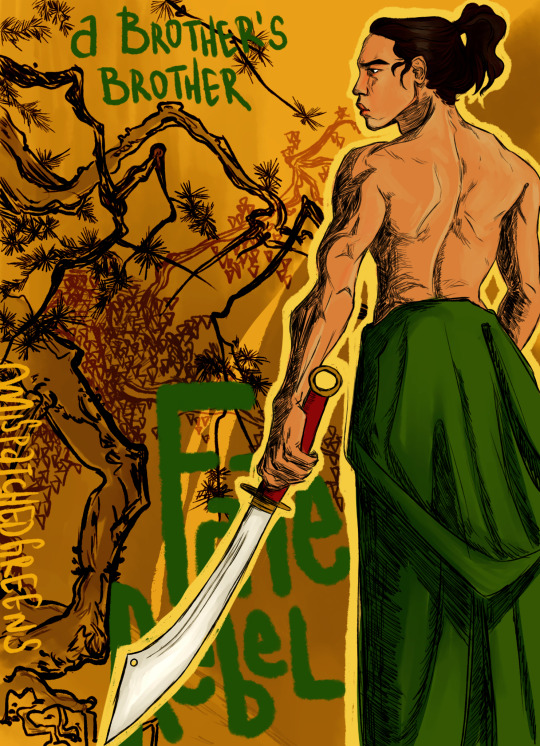
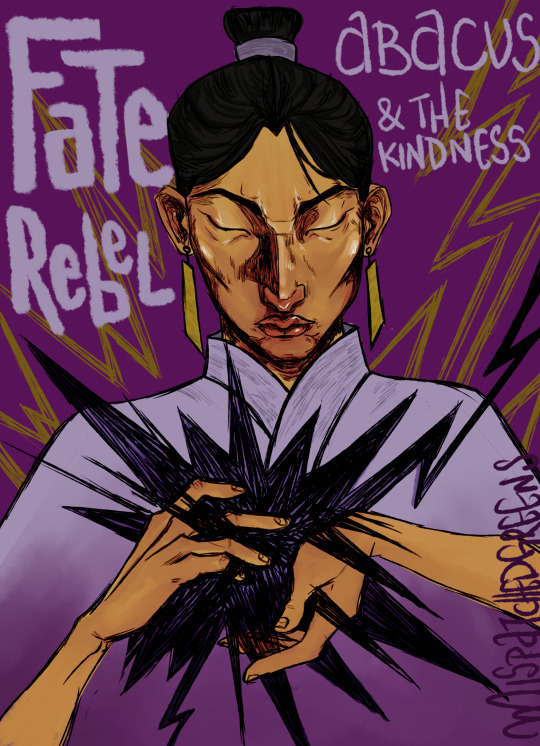
more tre shounen manga chapter covers!
some notes: 1. xu da's blade here is the dadao, or the big sabre. i swear this isn't a pun, it's different da characters. 2. the background is refencing a specific early 13th century painting, ma yuan's 'scholar viewing a waterfall'. (go look at the original, zoomed in, at the met museum site). 3. the abacus and the suanpan coexisted historically across the world from each other, but if one inspired the other is unclear (according to my shoddy research)
#the radiant emperor#she who became the sun#he who drowned the world#xu da#wang baoxiang#my art#drawing those pine tree branches probably one of the most relaxing things I've drawn in my life#as you can see I'm still struggling w rendering skin and i will continue! to do so!#also in this bout of unprompted research i found out that the real historical figure xu da lived until his 50s and he too was a total GOAT#do with that what you will#idk what protected yous from me titling wbx's one as supermassive black hole and thus continuing the twilight jokes#but it happened so rejoice i guess
150 notes
·
View notes
Note
your Merlin x good omens comic is fantastic. I love every bit of it so far. I was having a rough day and I saw the newest part and it made me have loads of goopy feelings and I really needed that. thank you for making it! I love Arthur taking in all the little bits of Merlin's apartment, like looking at him graduating. very sweet. love your art!
Thank you!!!
At first the idea was to put a photo of Merlin with some historically relevant person, but I wasn't sure who to pick lol
#also because half of the super known historical figure are secretly super problematic so yeah#asks#silver-hourglass
104 notes
·
View notes